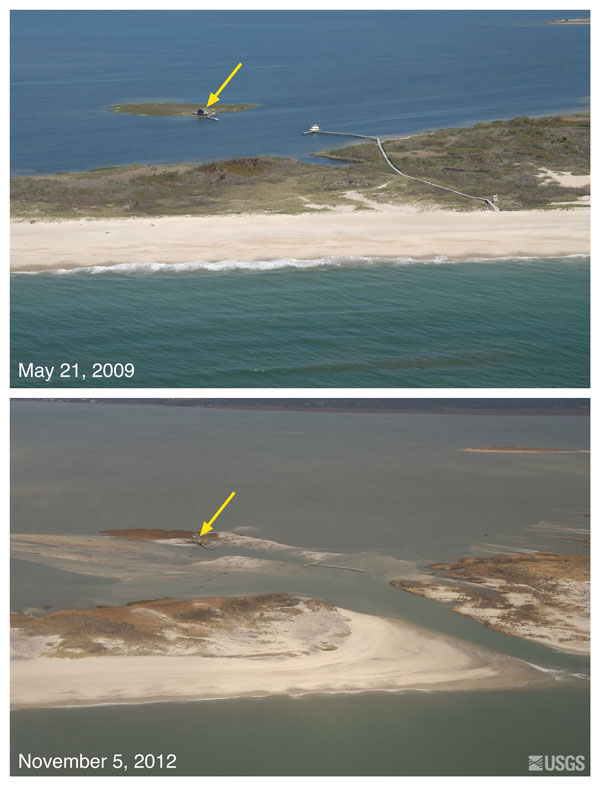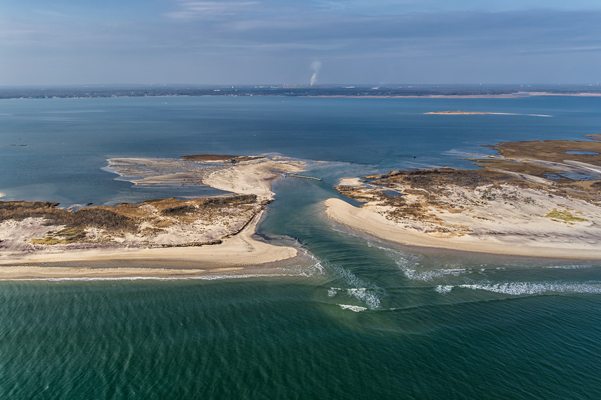Evaluation of a barrier-island breach created by Hurricane Sandy at Fire Island National Seashore, N.Y.—Continued.
Measurement of water velocities and depths on June 9, 2014 -- methods and results
Objective:
On November 6 and November 20, 2012, June 26 and November 13, 2013, and April 1 and June 9, 2014, U.S. Geological Survey (USGS) New York Water Science Center (NYWSC) personnel collected data to evaluate channel geometry, water velocity, and discharge of an open breach in the Federal Wilderness area of Fire Island National Seashore, N.Y. The breach resulted from major coastal flooding and overwash created by Hurricane Sandy on October 29, 2012. Data were collected using a Sontek1 M9 Acoustic Doppler Current Profiler (ADCP) with Real-Time Kinematic (RTK) Global Positioning System (GPS). Data were processed into Geographic Information System (GIS) for interpolation and display. The following information generally summarizes the measurement of water velocities and depths within the Wilderness breach on June 9, 2014.
Approach:
An initial series of transects was collected starting about 2-1/2 hours before ocean low tide on June 9, 2014. Data were collected perpendicular to flow through the breach beginning at 0746 Eastern Standard Time (EST) and ending at 0820 EST. The first set of transects was taken near the bayward side of the breach, with subsequent sets collected progressively closer to the seaward side of the breach. Discharge ranged from 19,900 ft3/s (cubic feet per second) during the beginning set of transects to 17,200 ft3/s during the final set of transects.
A second series of transects was collected starting about 3 hours before ocean high tide on June 9, 2014. Data collection began at 1349 EST and ended at 1508 EST. The first set of transects was taken near the seaward side of the breach; subsequent sets were generally collected progressively closer to the bayward side of the breach. Discharge ranged from 23,000 ft3/s during the beginning set of transects to 27,300 ft3/s during the final set of transects.
Data for overlapping transects are not shown in the incoming and outgoing tide discharge figures but are available with other measurements for this station.
Additional data were collected along the approximate centerline and adjacent to the shores of the channel, as well as perpendicular to the flood tidal channels bayward of the former Great South Bay (GSB) shoreline, to map the inundated area of the breach. The overall mapped area includes data collected during discharge measurements of both incoming and outgoing tide conditions. The Digital Elevation Model (DEM) was created by plotting the depths of all data points collected relative to North American Vertical Datum of 1988 (NAVD 88) and interpolating the elevation of the bathymetric surface between these points.
Available products:
<< 7 of 7
|
Aerial Photographs of Wilderness breach—Before & After Hurricane Sandy
Oblique aerial photographs of Pelican Island and Fire Island, New York. The
view is looking northwest across Fire Island towards Great South Bay. This
location
is within Fire Island National Seashore near Old Inlet—a very narrow
portion of the
island that has experienced breaching in previous large storms.
The island breached during
Hurricane Sandy, creating a new inlet. Despite the
breach, the fishing shack (yellow arrow) remained standing. Click on image to
enlarge.

Aerial view of the Wilderness breach at Old Inlet, looking from the Atlantic Ocean
to Great South Bay, on Saturday, November 10, 2012. NPS Photo/Abell.

Related Links:
Hurricane Sandy Information
|